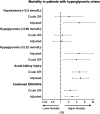Clinical Outcomes in Patients With Isolated or Combined Diabetic Ketoacidosis and Hyperosmolar Hyperglycemic State: A Retrospective, Hospital-Based Cohort Study
- PMID: 31704689
- PMCID: PMC6971788
- DOI: 10.2337/dc19-1168
Clinical Outcomes in Patients With Isolated or Combined Diabetic Ketoacidosis and Hyperosmolar Hyperglycemic State: A Retrospective, Hospital-Based Cohort Study
Abstract
Objective: Many patients with hyperglycemic crises present with combined features of diabetic ketoacidosis (DKA) and hyperosmolar hyperglycemic state (HHS). The implications of concomitant acidosis and hyperosmolality are not well known. We investigated hospital outcomes in patients with isolated or combined hyperglycemic crises.
Research design and methods: We analyzed admissions data listing DKA or HHS at two academic hospitals. We determined 1) the frequency distributions of HHS, DKA, and combined DKA-HHS (DKA criteria plus elevated effective osmolality); 2) the relationship of markers of severity of illness and clinical comorbidities with 30-day all-cause mortality; and 3) the relationship of hospital complications associated with insulin therapy (hypoglycemia and hypokalemia) with mortality.
Results: There were 1,211 patients who had a first admission with confirmed hyperglycemic crises criteria, 465 (38%) who had isolated DKA, 421 (35%) who had isolated HHS, and 325 (27%) who had combined features of DKA-HHS. After adjustment for age, sex, BMI, race, and Charlson Comorbidity Index score, subjects with combined DKA-HHS had higher in-hospital mortality compared with subjects with isolated hyperglycemic crises (adjusted odds ratio [aOR] 2.7; 95% CI 1.4, 4.9; P = 0.0019). In all groups, hypoglycemia (<40 mg/dL) during treatment was associated with a 4.8-fold increase in mortality (aOR 4.8; 95% CI 1.4, 16.8). Hypokalemia ≤3.5 mEq/L was frequent (55%). Severe hypokalemia (≤2.5 mEq/L) was associated with increased inpatient mortality (aOR 4.9; 95% CI 1.3, 18.8; P = 0.02).
Conclusions: Combined DKA-HHS is associated with higher mortality compared with isolated DKA or HHS. Severe hypokalemia and severe hypoglycemia are associated with higher hospital mortality in patients with hyperglycemic crises.
© 2019 by the American Diabetes Association.
Figures


References
-
- Zhong VW, Juhaeri J, Mayer-Davis EJ. Trends in hospital admission for diabetic ketoacidosis in adults with type 1 and type 2 diabetes in England, 1998-2013: a retrospective cohort study. Diabetes Care 2018;41:1870–1877 - PubMed
-
- Rosenbloom AL. Hyperglycemic hyperosmolar state: an emerging pediatric problem. J Pediatr 2010;156:180–184 - PubMed
-
- Umpierrez GE, Kelly JP, Navarrete JE, Casals MM, Kitabchi AE. Hyperglycemic crises in urban blacks. Arch Intern Med 1997;157:669–675 - PubMed

